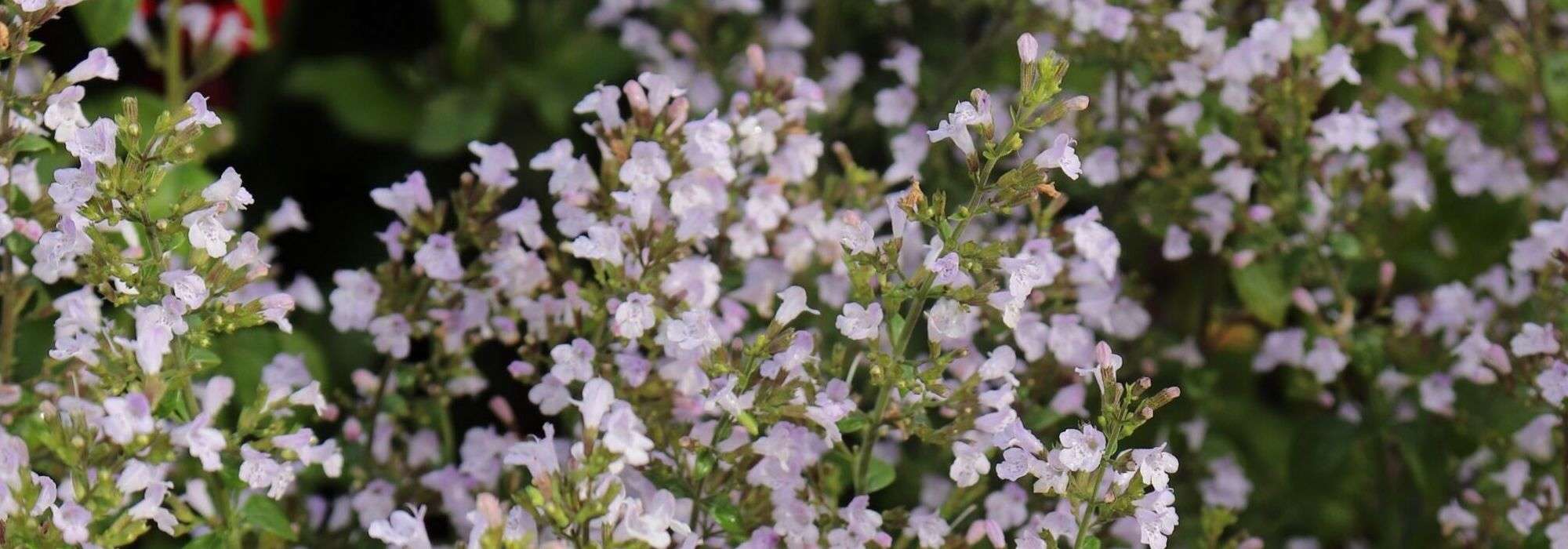
Calamintha: planting, caring for, harvesting
Contents
Calamint in a nutshell
- Calamint is a small aromatic perennial of dry, sunny areas, closely related to catmint
- The flowers with a delicate menthol fragrance are often purple, sometimes white or pink, and last all summer until the first frosts
- Its edible foliage releases an intense mint aroma when crushed
- It is a very easy plant to grow in any well-drained soil and requires little maintenance
- Hardy, it is ideal for natural or wild gardens
A word from our expert
The calamint or Calamintha is a fragrant plant closely related to catmint, with a pleasant scent reminiscent of lemon balm and mint, commonly found in the garrigues and along paths in Corsica and the Mediterranean region. Its foliage is fragrant and aromatic, making it valued in cooking for its properties and medicinal virtues for pain relief and digestion.
It is a remarkable perennial for its very long and delicate summer flowering, often blue-violet, sometimes white or pink.
Calamintha officinalis (or Calamintha sylvatica), Calamintha grandiflora or “large-flowered calamint” also known as “Aubrac Tea,” and Calamintha nepeta, there are many species and varieties.
It thrives when planted in full sun, in well-draining soil.
Perfectly hardy, it is easy to grow in Mediterranean-style gardens and dry gardens, in a scree garden, in rockeries, in borders, or along a gravel path.
With its highly fragrant and edible foliage and charming small flowers, it adds a touch of simplicity to natural, wild gardens or romantic gardens until frost.
Discover calamint, this simple perennial with a very refreshing scent!
Description and Botany
“`html
Botanical data
- Latin name Calamintha
- Family Lamiaceae
- Common name Calamint
- Flowering June to October
- Height 0.30 to 0.80 m
- Exposure Sun, partial shade
- Soil type well-drained
- Hardiness -15°C
The Calamintha, also known as Calamint is an aromatic perennial plant, belonging to the large family of Lamiaceae, a relative of mint, sage, catnip, and lemon balm. It grows wild in clear underwoods, sunny fallows, meadows, and scrublands of Southern Europe, North Africa, and the Middle East.
There are fewer than ten species, including Calamintha grandiflora or large-flowered calamint, Calamintha sylvatica or Calamintha officinalis, the “true” calamint also known as wood savory, and Clinopodium nepeta subsp. sylvaticum, Calamintha nepeta, small calamint, or glandular calamint. Each has given rise to cultivars with differing flower colours.
This small rhizomatous plant forms a tuft that is often creeping with a bushy and highly branched habit, reaching heights of 30 to 80 cm in all directions, spreading slowly through its running rhizomes but without the invasive character of its close relative, garden mint.
In spring, soft, rectangular-section stems emerge in a small cushion of deciduous to semi-evergreen leaves depending on the climate. Short-petiolate, they are arranged in pairs on the stems, oppositely, oval to oblong with slightly dentate edges. Shiny or villous, depending on the species, crinkled with prominent veins, they measure 5 cm long. They are pale green to grey-green and turn creamy in variegated varieties (Calamintha grandiflora ‘Variegata’). They strongly resemble those of mint and are aromatic and perfectly edible. They have a spicy, lemony flavour reminiscent of both mint and marjoram when crushed.
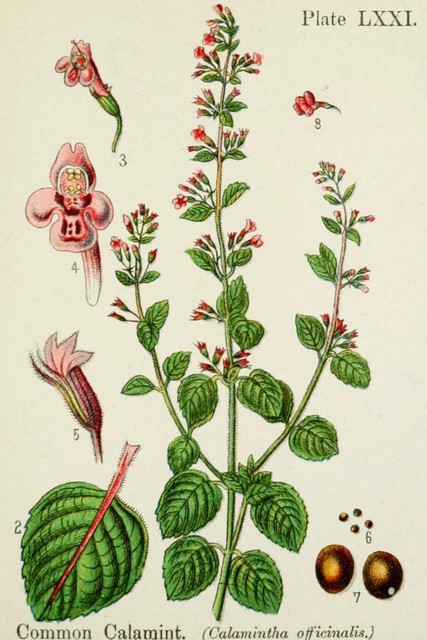
Calamintha officinalis – botanical illustration
On this bushy vegetation, flowers appear in a light and fragrant cloud in the axils of the upper leaves from June until the end of summer, borne at the top of the stems. They are arranged in racemes and gathered in loose clusters all facing the same direction, supported by a common peduncle.
Tubular in shape, they open into a two-lipped corolla measuring 2 to 8 cm long. Calamintha grandiflora has slightly larger flowers (7-8 cm) than the other species. These numerous small bell-shaped tubular flowers bloom in soft or bright shades, ranging from vivid carmine pink to purple, lavender, or pure white.
These delicate spikes, measuring 25 to 35 mm in length, are particularly nectariferous and melliferous, emitting a very refreshing menthol scent that irresistibly attracts bees and butterflies.
After flowering, the flowers transform into small fruits containing numerous seeds.
Very cold-resistant down to -15 to -20°C, calamint can be found throughout France. It grows easily in full sun, in any well-drained soil, even calcareous and stony.
Versatile, Calamintha can be planted alone, at the edge of a wild-looking flowerbed or pathway, and of course in a herb garden.
The entire plant is aromatic and exudes a scent of mint, lemon, pepper, and lavender. In cooking, its leaves can replace mint and are part of a culinary herb mix (za’atar) with oregano and thyme, widely used in the Middle East. This herb will flavour herbal teas, infusions, drinks, or even peaches in syrup. It also has many therapeutic, digestive, and calming properties and is known to relieve migraines and painful menstruation.
“`
Main species and varieties
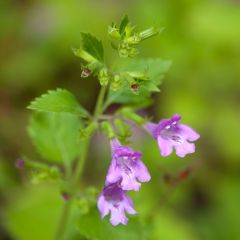
Calamintha grandiflora - Calamint
- Flowering time July to September
- Height at maturity 50 cm
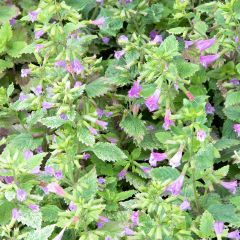
Calamintha grandiflora Variegata - Calamint
- Flowering time July to October
- Height at maturity 30 cm
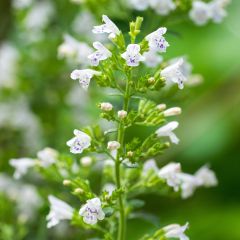
Calamintha nepeta - Calamint
- Flowering time July to November
- Height at maturity 40 cm
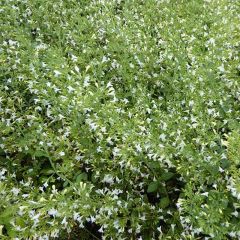
Calamintha nepeta Weisse Riese - Calamint
- Flowering time July to November
- Height at maturity 40 cm
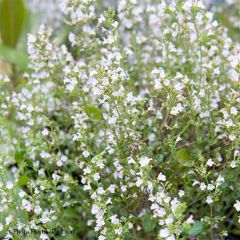
Calamintha sylvatica Menthe - Calamint
- Flowering time July to October
- Height at maturity 40 cm
Discover other Calamintha
View all →Available in 2 sizes
Available in 1 sizes
Available in 1 sizes
Available in 1 sizes
Available in 1 sizes
Available in 1 sizes
Available in 2 sizes
Planting
Where to plant Calamintha?
The Calamintha or calaminth grows in all our regions, easily tolerating cold down to -15°C to -20°C. This perennial from the Mediterranean region requires a sunny position, although it can also accept partial shade and dry shade under trees and bushes.
Not demanding, it adapts to any soil, even poor or stony, preferring dry, sandy, or calcareous soil, but will tolerate richer and cooler soil only if well-drained. Soil that is too compact and wet in winter may cause the roots to rot.
Provide it with a location where it can comfortably spread its suckering stems. It can be used for ground cover.
It grows in bushy clumps in the wild areas of the garden and will also thrive in a woodland garden.
It is ideal for natural or wild gardens, along a path to fragrance the air as you brush past, to flower at the edge of a walkway, or to lighten summer borders. It is also useful for covering the base of roses or in light undergrowth. As it tolerates poor soils and relative dryness well, it can also be planted in a large rockery or mineral garden, or to cover a well-exposed slope.
It naturally finds its place in the herb garden where its fragrance attracts pollinators.
When to plant?
Planting of the calaminth should be done in spring, preferably from February to April in regions where winter is cold and wet, as the roots may rot if planted in autumn or from September to November, after frosts and outside of intense heat.
How to plant?
For group planting: plant the calaminths at 5 plants per square metre and maintain about 50 cm distance between plants to create a beautiful mass effect.
- Loosen the soil well to aerate it and remove weeds
- Dig a hole 2 to 3 times the volume of the root ball
- In heavy soil, improve drainage if necessary with gravel or coarse sand
- Place the plant in the hole and fill with garden soil
- Water
- Discover more planting tips – How to plant perennials?
Read also
10 perennial plants for calcareous soilMaintenance: watering, pruning, harvest
The calamint is an easy plant that requires little maintenance. It is not afraid of drought or cold. While it tolerates soils dried out by tree roots, provide it with regular watering during the first year. After that, only water in cases of prolonged drought, knowing that flowering may be diminished during hot, dry summers.
Regularly remove faded flowers to encourage new flowering.
When flowering is finished, in autumn or late winter, cut back the clump by about one third and remove all the dry stems: leave the cut foliage on the stump to protect it throughout the winter.
Divide the clumps every 4 to 5 years to rejuvenate the plant.
Harvesting Calamintha
As the leaves of the Calamint are aromatic and possess stimulating and sedative medicinal properties, do not hesitate to harvest them as needed! Do this in June or July just before flowering. You can use them fresh to flavour dishes and desserts, or dry them and store them for use in herbal teas and infusions.
Diseases and potential pests
In terms of diseases, Calamintha is a resilient plant that truly fears only powdery mildew. This is a fungal disease characterised by the appearance of a white, powdery coating on the foliage. Remove the affected parts, water without wetting the foliage, and spray a horsetail decoction.
At the start of the growing season, protect it from slug attacks with our 7 ways to fight slugs effectively and naturally.
Multiplication
The Calamintha is easy to propagate from its seeds harvested in autumn from the garden. Propagation by cuttings is also possible. Dividing the clumps in spring from a plant that is at least 2 years old helps to ensure the plant’s longevity.
By sowing
Sowing Calamintha is done in spring in a warm greenhouse. Follow our tips to successfully sow your perennial plants!
By dividing clumps
This is done on mature clumps that are at least 2 years old.
- Using a fork, lift the clump
- With a spade, take a nice section that includes suckers
- Replant in pots until the offsets are well-rooted before planting them in the garden
Associate
With its simple appearance, Calamintha easily finds its place in all natural and wild gardens, in the romantic beds of a cottage garden, sunny rockeries and Mediterranean slopes, clear woodland edges like in naturalistic meadows, and of course in an herb garden.
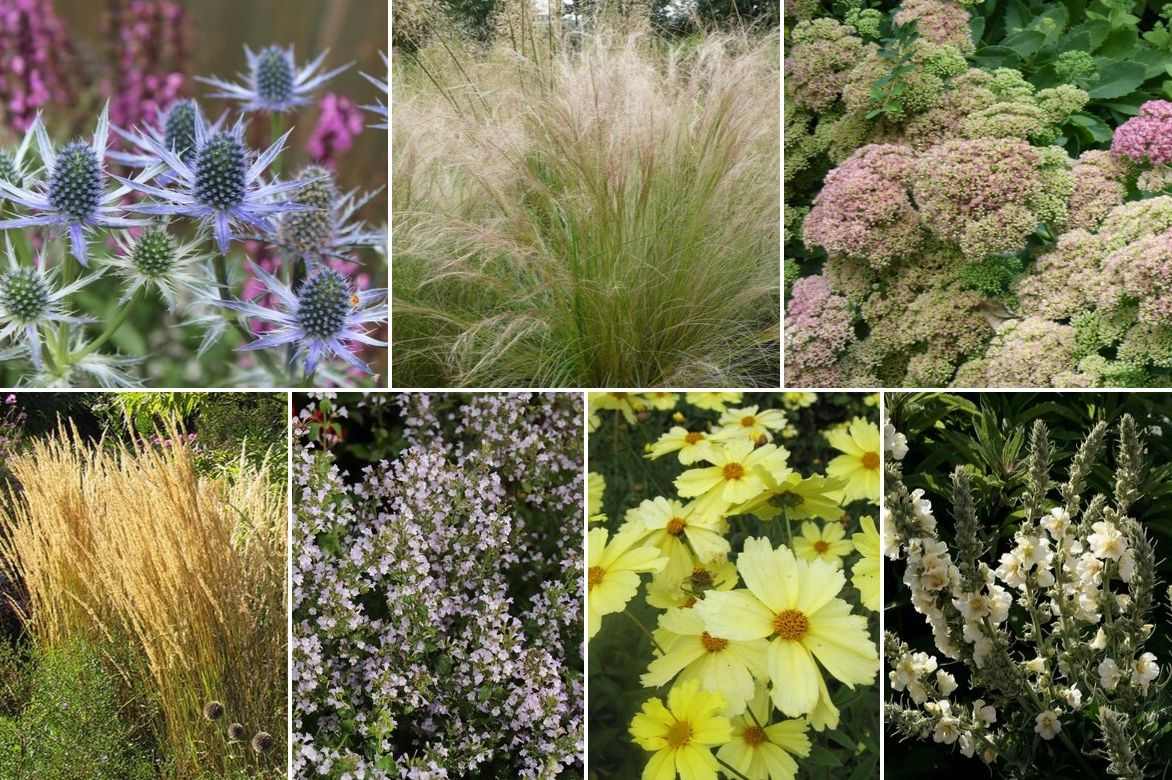
A naturalistic association idea in well-drained soil: Eryngium ‘Jos Eijking’, Stipa tenuifolia, Sedum ‘Herbstfreude’, Calamagrostis acutiflora ‘Karl Förster’, Coreopsis ‘Full Moon Madness’, Calamintha nepeta, and Verbascum phlomoides ‘Spica’
Its flowering in soft colours makes it essential in scenes of romantic inspiration, to accompany the delicacy of roses, and its foliage helps to hide the often bare base of bush roses. It blends well with clematis, Campanula lactiflora, or the light flowering of astrantia and gypsophila.
Varieties with purple or blue flowers will provide beautiful contrasts with yellow blooms, such as Achillea ‘Terracotta’, Coreopsis, or rudbeckias.
The airy flowering of calamintha pairs perfectly with the silver foliage of Stachys bizanthina and lanata, some Artemisia, mouse ears, Dianthus plumarius, and garden catchfly.
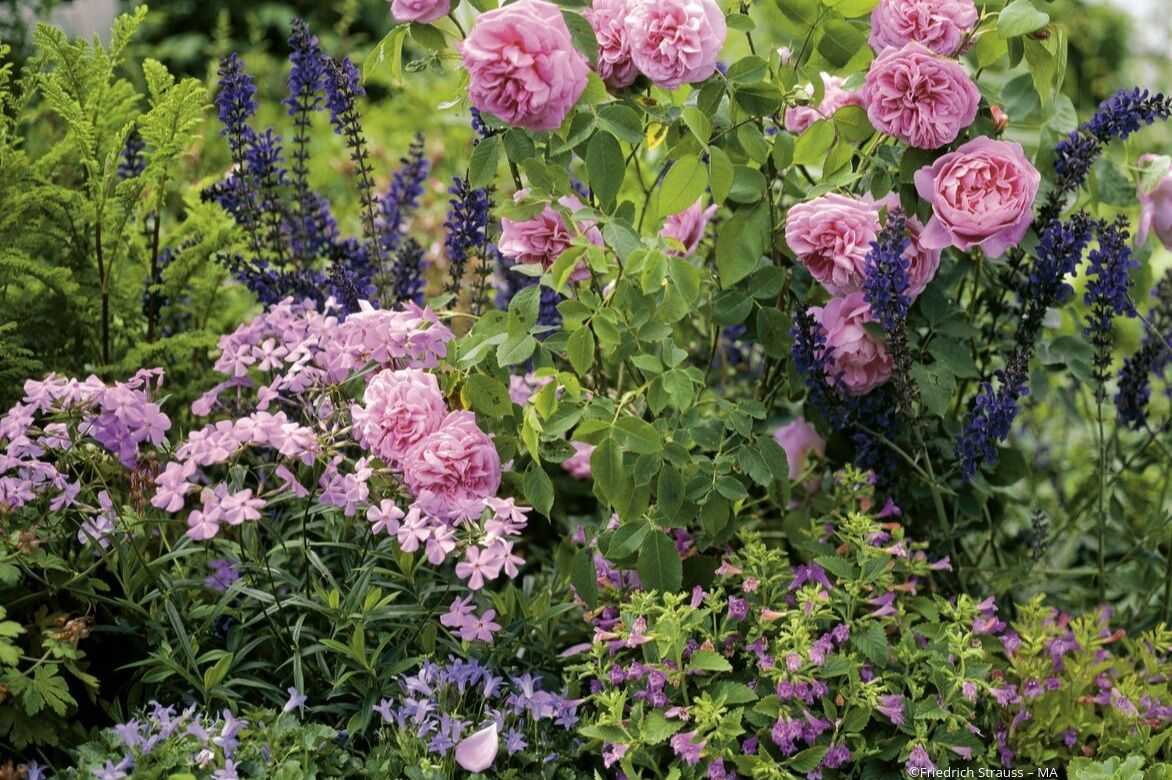
An example of a romantic association: Rose ‘Gertrude Jekyll’, Calamintha grandiflora, Salvia nemorosa (‘Mainacht’ for example), Phlox carolina ‘Bill Baker’, and Campanula poscharskyana ‘Stella’
In a wild-looking bed, it will accompany Achilleas, Salvia, hardy geraniums, agastaches, and Phlox paniculata. Dot with a few small tufts of grasses (Stipa tenuissima and pennata, Carex, Briza media…).
Plant it at the front of a border in front of taller perennials that will provide structure and height, such as mulleins (Verbascum) or shrubby salvias, at the base of tall floral spikes of foxgloves, veronicastrum, or large flowers of dahlias, purple coneflowers, and alliums.
As it enjoys full sun and well-drained soils, it will also find its place in a Mediterranean-inspired garden, a dry garden with a mineral predominance, where it can coexist with lavenders, dryland euphorbias, and eryngiums.
In a rockery, it will accompany dwarf wormwoods, erigeron, Ceratostigma plumbaginoides, armérias, thyme, or creeping rosemary, carnations, moss phlox, and Campanula muralis.
Useful resources
- Discover 5 ideas for pairing Calamintha
- Do you have a wooded garden? The best perennials for dry shade are with us!
- Our video tips – How to plant perennials
- Subscribe!
- Contents
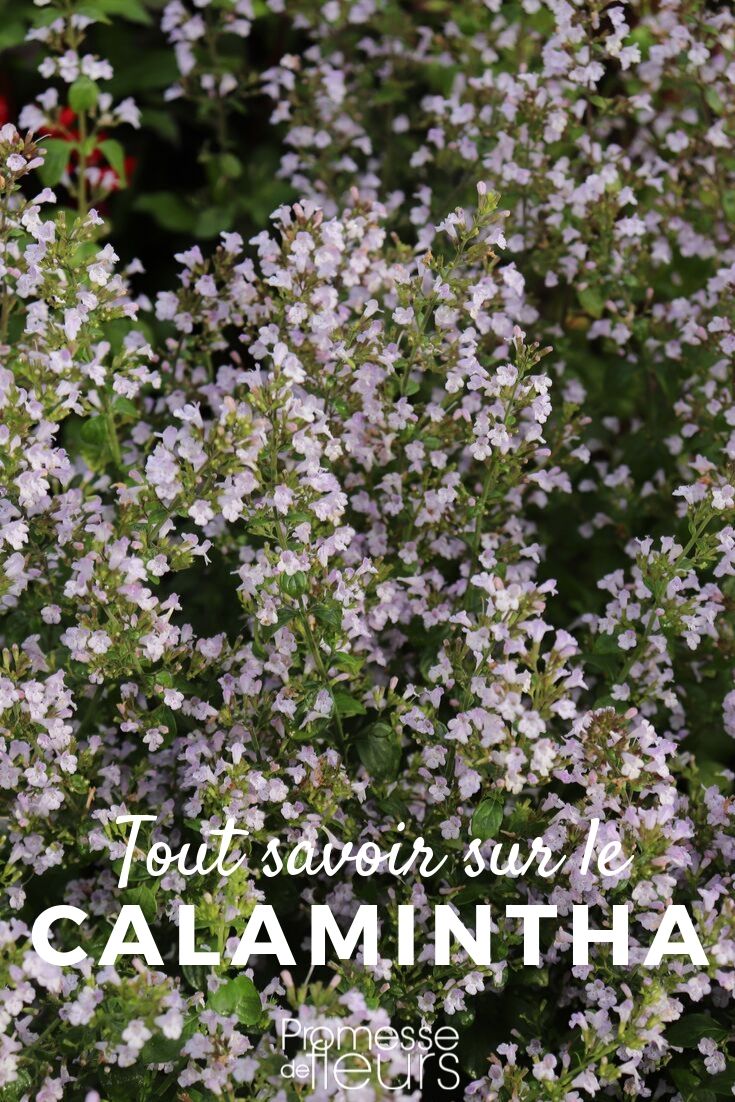

































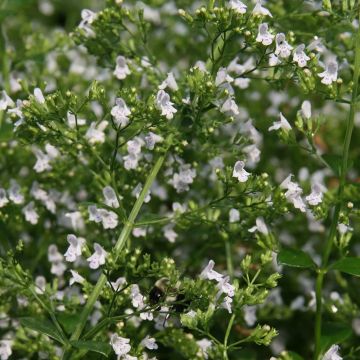





Comments